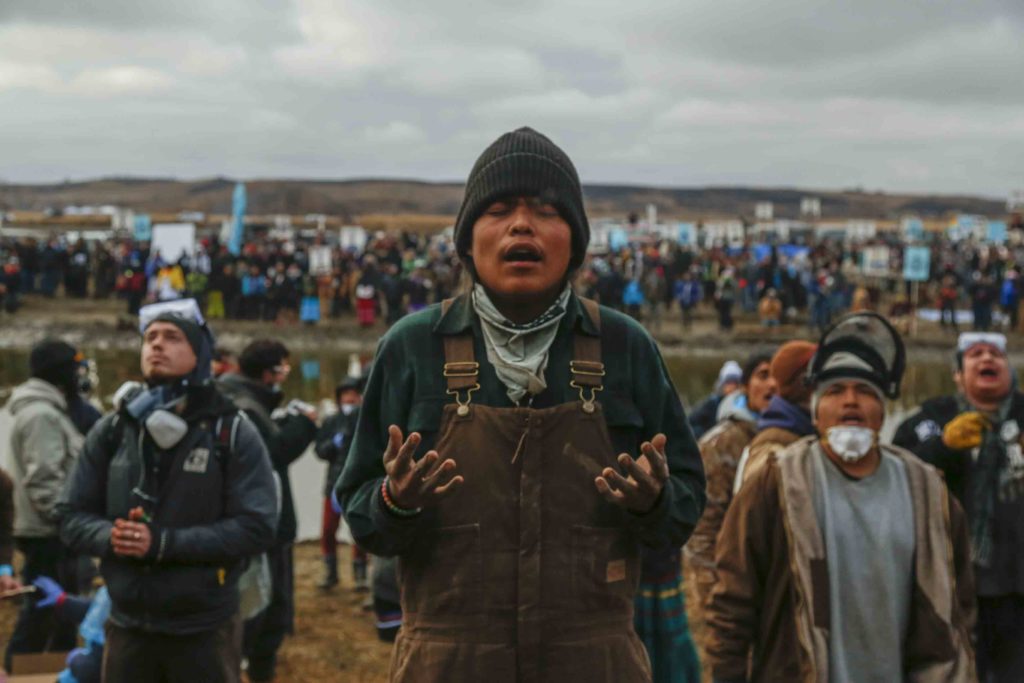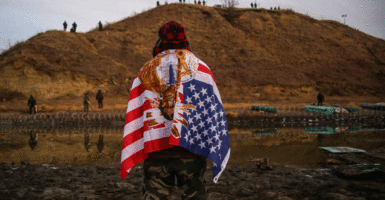Cody Schulz, chairman of the Morton County Commission in North Dakota, is keeping especially close track of a conflict over an oil pipeline that would run through his community.
By his count, Wednesday was the 113th day of protests over the Dakota Access pipeline, which has become a complex battle—sometimes involving violent clashes between police and demonstrators—over tribal rights, energy development, and the environment.
“The local residents of Morton County are fatigued and frustrated,” Schulz told The Daily Signal in an interview.
This week, state and local officials have applied pressure to end the standoff.
On Monday, North Dakota Gov. Jack Dalrymple, a Republican, ordered a mandatory evacuation of protesters seeking to block construction of the Dakota Access pipeline, a 1,170-mile transport vessel that would carry as much as 500,000 barrels of crude oil daily from the Bakken production region of North Dakota to an existing pipeline in Patoka, Illinois.
The local sheriff’s office, meanwhile, is warning that anyone delivering supplies to the protesters could be fined.
Morton County, just above the southern border of North Dakota, has a population slightly under 29,000, making it one of the state’s most populous counties. Thousands are protesting at camps located on U.S. Army Corps of Engineers land, north of the Cannonball River in Cannon Ball, North Dakota.
Both the state of North Dakota and the U.S. Army Corps of Engineers say they have no plans for “forcible removal” of the protesters, an eclectic mix that includes members of Native American tribes, liberal activists, and environmentalists.
Despite the warnings, both supporters and opponents of the oil pipeline have vowed to continue fighting through the harsh North Dakota winter.
As the controversy rages on, The Daily Signal examines key factors contributing to division over the pipeline, and how the various parties may move forward.
Issues at Stake
The Standing Rock Sioux, a tribe of about 10,000 leading the protests, fear the Dakota Access pipeline could pollute the Missouri River, the tribe’s main source of drinking water, and harm sacred cultural lands and tribal burial grounds.
Standing Rock is contesting a segment of the pipeline planned to run under Lake Oahe, a reservoir formed by a dam on the Missouri River.
The tribe, working with the environmental group Earthjustice, filed suit July 27 against the Army Corps of Engineers, arguing the government did not properly consult them before approving the section of pipeline near the Standing Rock Indian Reservation.
This litigation is ongoing, although the U.S. District Court in Washington, D.C., refused to halt construction of the pipeline while the case winds through the legal system.
>>> Commentary: The Pipeline Facts Protesters Don’t Want You to Know
Energy Transfer Partners, the company building the pipeline, says it has followed federal and state rules, and argues that the project is a safer and cleaner way to transport crude oil from fields to refineries.
It says it adequately met with Native American tribes, and proposed different variations of the pipeline’s route.
The company says its pipeline does not enter the Standing Rock reservation. In November, it filed a countersuit in the same federal court asking to proceed with the $3.7 billion project.
The pipeline is 92 percent complete, and just a small portion of it nearest to the Standing Rock reservation remains in limbo, as the Army Corps of Engineers decides whether to grant a final permit for Energy Transfer Partners to finish it.
On Nov. 2, President Barack Obama issued a statement saying the Army Corps “is examining whether there are ways to reroute this pipeline.”
“We’re going to let it play out for several more weeks and determine whether or not this can be resolved in a way that I think is properly attentive to the traditions of the first Americans,” Obama said.
But on Tuesday, the White House said it is not aware of “any impending presidential actions” in the foreseeable future.
Supporters of the pipeline expect President-elect Donald Trump to quickly allow its completion after he is sworn in Jan. 20.
Deeper Grievances, Alliances
Aseem Prakash, director of the Center for Environmental Politics at the University of Washington, contends that the Standing Rock tribe’s stake in the conflict reflects deeper-seated grievances of Native Americans.
“The American Indian community, at least some sections of it, is aggrieved over the years about injustices, essentially the notion being—right or wrong—that their preferences are not taken into account seriously,” Prakash told The Daily Signal in an interview. “The Dakota pipeline is epitomizing their perspective of injustice.”
Though the pipeline goes through private land and not Native American property, the tribe contends this land was acquired improperly and actually belongs to them by the terms of a 1851 treaty with the U.S. government.

During a Nov. 23 protest targeting the Dakota Access pipeline, Frankie Tso Jr. prays among other demonstrators at the foot of a hill off the Missouri River surrounding the Standing Rock Indian Reservation. (Photo: Natasha Dangond/Polaris/Newscom)
North Dakota’s at-large member of the House of Representatives, Republican Kevin Cramer, acknowledges the tribe’s grievances and says they are exasperated by high rates of poverty in the Native American community.
But Cramer sees these “legitimate concerns” as being clouded by the tribe’s alliance with environmental groups that have broader concerns about pipelines in general:
The biggest losers in their issues being heard are the tribes. The concern of the environmentalists are not based on intellect or knowledge or reality, and I think all of that dilutes legitimate concerns of the tribes that call out for broader discussion.
Indeed, after successfully influencing the Obama administration to reject the Keystone XL oil pipeline, environmental groups latched onto the North Dakota project as the next frontier as it aims to limit fossil fuel use and delivery.
“For environmentalists, this is an excellent alliance,” Prakash said, adding:
This is a very good opportunity for them because the best way to bankrupt fossil fuel companies is to target the supply chain—the modes of transportation. Some tribe members think their issues are being hijacked. For them, this is not a war on fossil fuel. It’s a specific argument about not honoring the historical practices of Native Americans and about rerouting this particular pipeline.
Police Clashes
Media reports have documented violent clashes between police and protesters.
Authorities have used rubber bullets, pepper spray, and water cannons against demonstrators, according to the tribe, and hundreds have been injured.
“The state has overreacted,” Prakash said. “You don’t need a militarized response to a peaceful protest. You don’t need cops in Humvees. It looks like a military operation. In any democratic society, the right to protest is a fundamental right.”
Many public officials, including Cramer and Schulz, the Morton County Commission chairman, defend the force used by police, however.
They say that some out-of-state protesters have instigated the violence, and they view the protest as an illegal occupation of federal land.
“Our law enforcement has exercised incredible restraint,” Cramer said. “We are living in a time where officers are executed at point-blank range on a regular basis. One thing about North Dakotans is we don’t confuse enforcing the law with breaking the law.”
Whose Issue to Solve
All parties agree that the Obama administration is running out of time to see through the end of the conflict.
Yet local officials are waiting for help.
Schulz says he is frustrated with Washington because the federal government’s indecision has prolonged the demonstrations and drained local law enforcement money.
Requests for federal law enforcement assistance have been denied, he said, adding:
Absolutely this a federal issue. We are talking about a federal easement, this case has been heard in federal court, the protests are occurring on federal property, and the federal agencies are the ones that put the pipeline on hold. The federal government has failed miserably at addressing it.
Cramer and Schulz say they expect the Trump administration to act in their favor by backing the Dakota Access pipeline.
Cramer says he already has spoken with Trump’s nominee for attorney general, Sen. Jeff Sessions, R-Ala., about receiving federal funds to reimburse local and state emergency response and law enforcement costs.
“Trump’s pledge that he wants to see the rebuilding of infrastructure in this country lends itself beautifully to getting out of the way with this project,” Cramer said. “I expect that should happen very quickly.”
Even after the pipeline’s future is resolved, local officials say, they recognize the underlying feelings that drove the protests won’t be healed quickly.
“Healing begins with sitting down in the same room and talking,” Schulz said. “It will take some time. If you can get to mutual understanding, even if it’s not agreement, that’s a step forward. Morton County and Standing Rock have been friends and neighbors for generations, and that won’t change.”
































One Reply to “The Dakota Pipeline Protests, Explained”